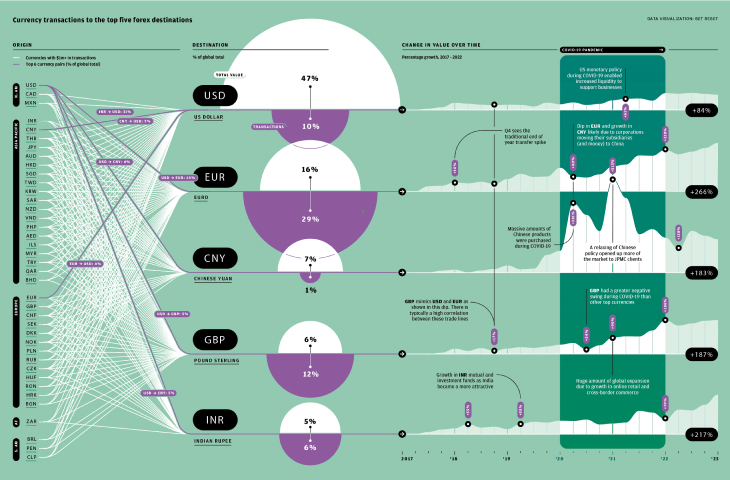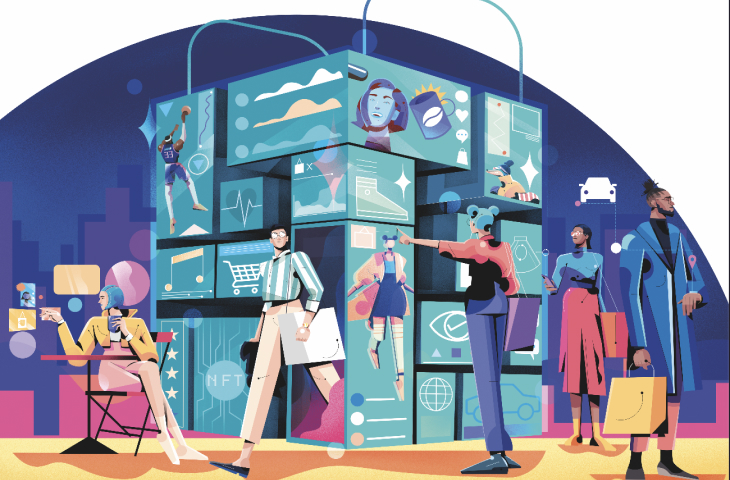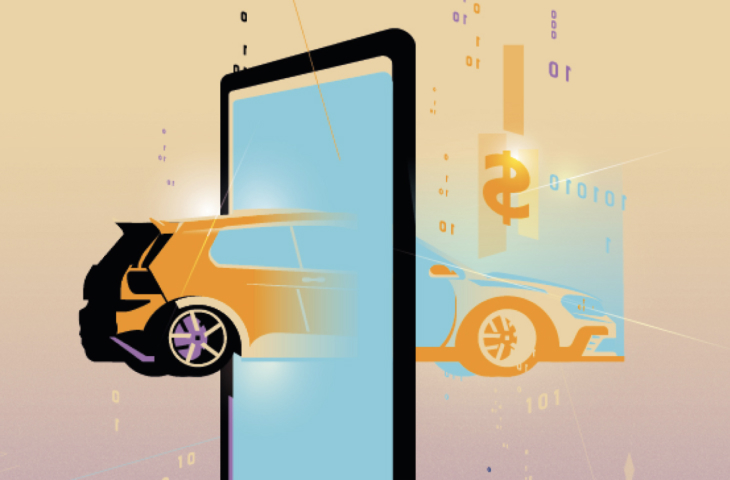
Endless aisles.
No checkouts.
Total immersion.
Welcome to the phygital store of the future
When Sears opened a new location on the outskirts of Rochester, New York, in 1990, it was one of the largest retailers in the world. Its pioneering idea had been to shift department stores, once the gleaming centerpieces of major cities, to suburban locations, where middle-class customers were increasingly located, and parking was ample.
That same store, long since shuttered, is now undergoing another transformation. It’s the latest in a long line of vacant Sears sites being redeveloped—in this case for retirement housing. It might seem like a fitting metaphor for the fate of traditional brick-and-mortar retail as it faces the ongoing e-commerce onslaught. From a peak of 3,500 locations, after its merger with KMart in 2005, there are just 15 Sears stores left. Many of America’s malls are facing a similar fate. Often, online retailers snap up the empty locations to turn them into fulfillment centers.
Yet shift your focus to Asia and it’s a different story. Physical retail is booming. In China, for instance, major brands are expanding their physical footprint—Starbucks is planning to have up to 9,000 stores in the country by 2025, Lego is opening another 80 in 2023, and China alone accounted for 40 percent of all luxury brand openings in 2022. So what’s different? One answer is that rather than try to compete with online retailers, a new breed of store is taking digital technology and using it to enhance the in-person experience. Take S’Young International, a Chinese beauty brand specialist, which has recently opened a flagship site in Changsha. This innovative space includes AI-powered make-up consultations and tailored recommendations from virtual assistants. Customers can purchase products in the store or use a QR code to buy from online platforms. Other retailers are tapping into the “instant retail” trend—combining online orders with ultra-fast delivery (via “quick commerce” services such as Meituan)—to raise their offline sales.
Western brands are also innovating, experimenting with new technologies such as driverless delivery and virtual reality experiences. Far from becoming a distant memory, stores could be set for a new lease of life that blurs the lines between the physical and the digital—a state that marketeers refer to as “phygital”. So what are the emerging trends that could define the future of retail, and what will that mean for payments? Join us for some informed speculation…
Death of the queue
Many shoppers, when faced with a long checkout line, have felt the urge to simply walk out of the store. Now they can, taking what they want without fear of arrest. Drawing on a combination of sensors, cameras, and radio frequency identification (RFID) tags, a store can track the items that customers pick from shelves. When they leave the premises, the goods are automatically charged to their online account. Once considered a novelty, checkout-free stores are predicted to grow globally from 250 in 2021 to 12,000 by 2027.
For stores that don’t wish to do away with checkouts altogether, there are a number of other innovations that instead seek to make the experience faster and more convenient. One is facial recognition systems. Already established in Asia, “smile-to-pay” is growing in the US and Europe and can dramatically reduce wait times. Another approach is for shoppers to use their smartphone. Jie Cheng, Vice President and Global Head of Digital Commerce at snacks company Mondelez International, recalls visiting the FairPrice store in Singapore recently, where customers use their smartphone to scan the barcodes of products as they put them in their basket, redeem loyalty points and then pay directly on their phone. They only need to verify their digital receipts with the large scanner screen right before they leave the premises. “So the whole transaction is happening on their mobile app while the person is in the store,” she says. “It is really a very integrated, blended experience. I believe Sam’s Club in the US also uses similar ‘scan and go’ technology in their stores. It’s certainly become more common now.”
Whatever the technology, the goal is to improve the last step of the shopping process. “Having a more fluid checkout is so important, whether it’s paying by tapping your watch to a store associate’s phone, or smiling at a camera at the checkout area,” says Lucia Li, who leads Advisory for the Consumer Goods and Retail team at J.P. Morgan Payments. “Online retailers know if you make it difficult to pay, you lose the sale. Brick-and-mortar are catching on and are looking for ways to reduce friction for consumers to complete that final step in the customer journey.”
Curing check-out woes with AI and Biometrics
Peter Czimback, vice president of digital experience for global hospitality services giant Aramark, says in conversation with Payments Unbound. Czimback founded and leads Aramark Emerge, a team of tech innovators dedicated to making retail faster and more convenient for its consumers, associates, and clients in places like hospitals, universities, sports and entertainment venues, and the workplace. He says curing checkout woes is core to this.
Aramark is a known payment-tech early mover, onboarding digital solutions to remove in-person checkout snags long before its competitors. For example, Aramark was a forerunner in computer vision technology, which it first deployed back in 2016. This is a subset of artificial intelligence (AI) that enables computers to derive meaningful information from digital images. In the case of retail, this means items can be recognized and scanned as a shopper puts them in their basket, removing the need for customers or staff to scan at the till. The tech has since been rolled out globally, cutting average Aramark self-checkout times down from one minute+ to around 13 seconds.
Aramark is now advancing its computer vision so they can get the check-out time down to zero. Whether it’s a caregiver in a hospital grabbing a healthy, fresh meal with a short break time or a weary commuter craving their daily caffeine hit, every second they can shave off the payments experience makes a difference.
Also boosting this rapid checkout experience is the addition of biometric payment methods. The time is takes to remove a credit card from a wallet, or even the action of using a mobile wallet, can be slow. Biometric payment methods – like using your face or palm to make purchases or verify age for alcohol purchases – helps to gain back those valuable seconds while offering strong security features to keep client and consumer data safe, both paramount for progressing new tech experiences. Yet despite his focus on applying cutting-edge digitization and AI to the in-store experience, Czimback says ultimately, tech should be in service of the consumer by making stores feel more human, enabling people to interact and transact better. “I'm a consumer experience person. It's what I and my team obsess over,” he says. Through payments tech, “I'm seeking one more moment to engage a consumer, one more opportunity to say “hi,” and being able to greet someone by their name and bring a little smile. If we do that the rest falls into place.
A wave of innovations are rethinking checkouts—or removing them altogether
Endless aisles
Stores will continue to stock physical items because people enjoy the experience of being able to see, touch, and feel the goods that they are buying, and having a sales associate guide their decision-making. After all, this is why customers don’t always order online. But new innovations are focusing on bringing the key elements and benefits of digital commerce into the physical space to elevate the customer experience.
Consider product aisles. Interactive screens in-store can show an extended range of options that aren’t on the premises, giving customers near limitless choice, alongside the kind of additional product information often found in e-commerce listings. One footwear brand, for example, has used an interactive 3D screen to display hundreds of sneakers, with customers able to zoom in on any they like and take a 360 degree view. This idea can also be brought into fitting rooms, with smart mirrors that use a version of augmented reality (AR) to show you how a piece would look in a different color or style, without having to try it on. A number of startups are already operating in this space.
It is also possible to use those screens to personalize the experience. Having identified the customer—perhaps via a near field communication (NFC) beacon or having them sign in with their membership account—and analyzed their preferences and past interactions, the displays could show relevant information, targeted storytelling, or tailored recommendations. That might be a clothing size, a recipe pairing based on previous purchases or, if a customer is interested in environmental issues, a short film on how the product was sourced.
Clearly, once those screens are part of the experience, they could also be used to ask for an associate’s assistance, place orders, and pay. What’s more, the pricing could be dynamic, reflecting factors such as inventory levels or wider commodity values. Customers could even be given a choice to order products at a later date, when prices are expected to be lower, like a mini-futures contract.
Dynamic pricing is already happening among online wholesalers. Frubana is a digital “one-stop-shop” in Latin America that connects restaurants and produce suppliers. “Customers can track prices on the app, and if they send a purchase order by 8pm they receive delivery the next morning,” says Gabriela Soares Bertho, the company’s Head of Finance Brazil.
Stores that don’t wish to install digital displays could co-opt customers’ personal devices, which would also solve the problem of having to identify the customer. “If you have the app in your hand, and it knows your location, and knows even what you shop for, it can give you recommendations or point you to exactly where you want to go,” says Nainesh Nayudu, Director of Product Management at grocery chain Albertsons. One use case could be special offers, agrees Cheng. “When the shoppers walk through each aisle”, she says, “relevant promotions could pop up on their app.”
Immersive experiences will give customers more reason to shop in-store
Rise of the “dark store”
If Sears could become a retail titan by designing around the car, then future stores may compete by eliminating the need for customers to drive there. What if shoppers no longer had to load up their SUVs with the weekly shop; what if, in fact, they didn’t have to carry any bags at all? Instead, as they move around the store, they could simply scan QR codes on physical items or choose products from in-store digital displays. Items they wanted then and there could be readied for collection in automated fulfillment portals near the exits, while anything else could be delivered to their home or another location via a same-day or even same-hour service. “Whether the customer starts online or in-store, you could have an increasing interdependency between the channels,” says Nayudu.
This type of flexible fulfillment would be aided by the rise of “dark stores”—mini-urban distribution centers that look much like regular stores but are closed to the public. Moving up and down the aisles are automated forklifts and robots that can detect, pick, and pack products for delivery. AI-based delivery platforms plot the quickest routes for the delivery drivers, although these too may soon become optional if delivery drones take off. By 2030, there are expected to be 45,000 dark stores around the world.
This shift would allow retailers to increase incremental sales by removing the friction caused by customers needing to carry purchases out of the store, and provide new opportunities to grow revenue by offering those delivery services.
Immersive experiences
If retailers can remove major friction points around checkout, payments and fulfillment, then customers will be
increasingly free to focus on the act of shopping itself. This is leading to a rise in what analysts have dubbed
“retaileasure”. “I think with in-store you have more opportunity to widen the sale, to get more
out of that consumer, because they’re enjoying the experience,” says Jennifer Acosta, Global Head of
Media and Telecommunications at J.P. Morgan. “It’s not just the products. It’s the mood.
It’s the feeling. It’s the ambience.” One luxury retailer in Beijing has a “Mars
Zone” in one of its stores, with life-size space vehicles and immersive, interactive experiences that take the
shopper into the Martian landscape. Another floor is called Future Farm, and includes pens of robotic sheep and an
interactive mirror where penguins mimic the movements of customers. Other retailers have carved out space for
experiential stations within their physical locations. At UNIQLO, for example, there is a real-time online shopping
experience called Live Station, hosted by stylists and staff members. At Levi’s stores, the SecondHand
offering allows customers to trade in their pre-used Levi’s items in return for gift cards.
These new concepts address one of the weaknesses of pure e-commerce players. For all their efficiency and convenience, they can also seem cold and functional. It’s hard for them to evoke positive emotions and connect to the end consumers. This provides an opportunity for brick-and-mortar retailers.
Increasingly, they understand that modern shoppers—especially younger generations—don’t just want spaces that they can browse; they want something exciting that can only be done or experienced in-store. That’s also leading them to double down on entertainment, engagement, and interaction using the latest tools at their disposal, such as virtual reality (VR).
Stores may start developing VR-based games that facilitate purchases—imagine a sports store with a realistic golf simulator that allows you to win discounts or store credit for good play. “Think about the huge population of gaming participants and how much it’s growing,” says Acosta. “Being able to have that experience in a store, with other people, as opposed to just behind a screen in your room, will be a super interesting development.”
Immersive experiences will give customers more reason to shop in-store
The store as a factory
The trend across the digital economy is towards personalization. This may come into physical stores as advances in 3D printing—which allows objects to be created from digital designs by robotically building them up in layers—enables products to be produced to order. For example, there are eyewear brands that allow people to scan their face and have customized frames made that match their features.
Imagine where this could go next. Shoppers could have the option to modify a brand’s product with their own ideas, and then have the new version created in-store, in a dedicated section. Creators could then share their designs for the best “mods” on a digital marketplace, making them available to other brand enthusiasts. Access to this platform could involve a small subscription payment, while revenue sharing models could incentivize people to contribute ideas. This, in turn, would allow brands to gain more control over the fast-growing customization market, which some are concerned about due to trademark and copyright issues. Custom shoes are already big business, with sales expected to top $1 billion by 2030, driven by the availability of 3D printing and e-commerce platforms. There is huge potential for growth in other apparel areas, as well as sports equipment such as bikes and skateboards.
So what does this mean for the “store of the future”?
Consumer demands for more choice, greater personalization, and unique seamless experiences across all aspects of their lives are only going to grow. As retailers deliberate the future of their physical footprint, many believe they will need to match these expectations—incorporating digital tools and seamless experiences into the physical space itself. They will need to create a new “phygital” world where customers will no longer have to follow a linear, formulaic journey in-store.
But there are benefits to retailers as well. The more connected and engaged consumers are—across any and all channels—the more data becomes available. Retailers can use this data to not only inform their decisions on new stores and store strategy—from merchandising to marketing activations to location choice—but to also monetize it as a new source of revenue by providing similar insights to brands they work with.
As with all retail trends, a fit-for-purpose payments system will be crucial to their success. “After all, without ways to monetize these concepts, they won’t be sustainable,” says J.P. Morgan’s Lucia Li.
“Whether it’s the ability to shop and pay real-time, a frictionless checkout with a tap or swipe of your palm, or embedded finance and banking options, the payments system is a crucial piece of the puzzle to help retailers and brands win over consumers in this increasingly competitive landscape.”
BY J.P. MORGAN
SOURCES: WWW.JPMORGAN.COM/PAYMENTSUNBOUND/SOURCES
ILLUSTRATIONS: JAMES GILLEARD















































